The Siamese algae eater (SAE) is a popular choice among aquarists for its remarkable ability to control algae in aquariums. Known for being one of the most efficient algae-eating fish, the SAE is particularly valued for its ability to consume types of algae that other species cannot, such as the tough black beard algae (BBA), which is often a persistent issue in tanks.
This fish is not only an effective cleaner but also a peaceful and relatively small species, making it an excellent addition to community tanks. Unlike many other fish, which may ignore algae or only eat specific types, the SAE actively grazes on various algae forms, contributing to a cleaner and healthier environment for other tank inhabitants.
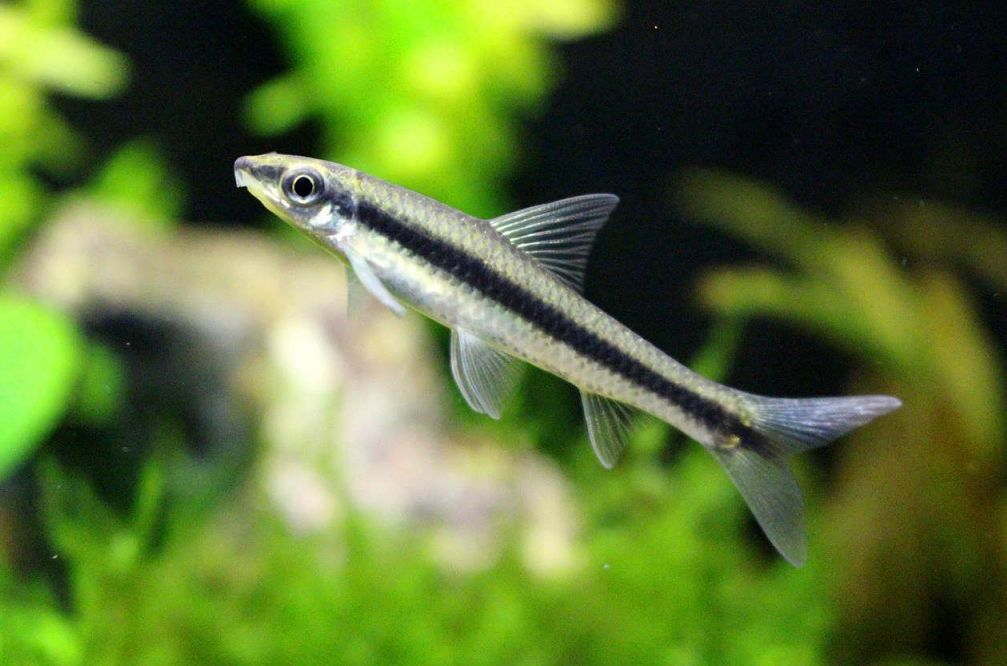
Contents
Habitat in the wild
The Siamese algae eater, belonging to the Cyprinidae family, is widely known for its efficiency in controlling algae growth in aquariums. This family includes other well-known freshwater species like carps, barbs, and danios. The Siamese algae eater shares common features with these fish, including a streamlined body, a single dorsal fin, and the absence of barbels around the mouth.
Though the Siamese algae eater was once classified under the Epalzeorhynchus genus, it is now part of the Crossocheilus genus. Despite changes in its scientific classification, this fish remains a favorite among aquarists for its utility in combating algae, particularly black beard algae (BBA).
Native to fast-flowing rivers and streams in Southeast Asia, particularly Thailand and Malaysia, Siamese algae eaters thrive in environments with clear water, rocky or gravel substrates, and abundant plant life. In these natural habitats, they are accustomed to moderate to strong water currents and well-oxygenated water. This is important to replicate in aquariums to ensure their health and activity levels.
In the wild, the Siamese algae eater’s diet consists primarily of algae, but they also consume plant material and small invertebrates. Their ability to feed on tough algae makes them an ideal solution for aquarists dealing with algae overgrowth in home tanks. In an aquarium, they continue this natural behavior, eating various types of algae, which helps maintain the tank’s cleanliness.
For aquarists looking to keep Siamese algae eaters healthy, it’s crucial to provide an environment that mirrors their natural habitat. A tank with strong water circulation, a gravel or sandy substrate, and plenty of plants will mimic the conditions of the fast-flowing rivers where they are naturally found.
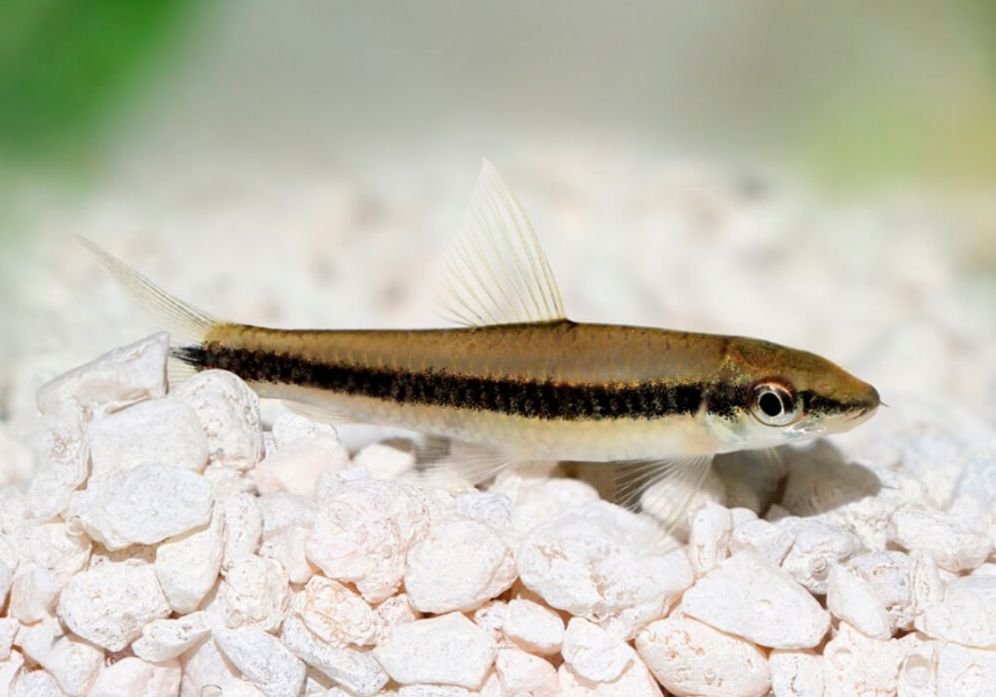
Description
Size
In the wild, siamese algae eater may grow up to 16 centimeters (6.3 in) large, while it is usually smaller in a tank – up to 12 cm (5 inches).
Lifespan
The Siamese algae eater typically has a lifespan of about 5 to 7 years in captivity. However, it’s important to note that individual lifespans can vary depending on various factors such as the quality of care, water conditions, diet, and genetics.
Keep in mind that fish lifespan estimates are based on general averages, and some individuals may live longer, while others might have shorter lifespans. Monitoring the health and behavior of your Siamese algae eaters can help you identify any potential issues and take appropriate actions to promote their longevity.
Body
The Siamese algae eater has an elongated, silvery body with a distinct black stripe running from the tip of its nose to the end of its tail fin. This stripe is not perfectly straight and has visible notches, which gives the fish a unique appearance. When stressed, this stripe fades to a light gray, serving as an indicator of the fish’s health or comfort level in its environment. This color change can be useful for aquarists as a signal of potential stress, such as poor water conditions or illness, allowing them to take timely action.
Above the black stripe, depending on the angle of the light, a faint, brighter stripe may be visible. This subtle iridescence adds an extra layer of visual interest, especially when the fish moves through well-lit areas of the tank, creating a shimmering effect that enhances its overall beauty.
The fins of the Siamese algae eater are almost completely transparent, without any noticeable color or tint. This transparency, combined with the fish’s streamlined body, allows it to blend seamlessly into its surroundings, providing a form of camouflage that is particularly beneficial in the wild, where it inhabits fast-flowing rivers with gravel and rocky substrates.
| Characteristic | Description |
|---|---|
| Scientific Name | Crossocheilus siamensis |
| Common Name | Siamese Algae Eater, SAE fish |
| Family | Cyprinidae |
| Origin | Southeast Asia (Thailand, Malaysia, etc.) |
| Size | Up to 6 inches (15 cm) in length |
| Lifespan | 5 to 10 years in captivity |
| Temperament | Generally peaceful and sociable |
| Water Temperature | 74°F to 79°F (23°C to 26°C) |
| pH Range | 6.5 to 7.5 |
| Water Hardness | Moderately soft to moderately hard |
| Tank Size | Minimum 20 gallons (75 liters) for a small group |
| Diet | Herbivorous – Algae, plant matter, and small invertebrates |
| Habitat | Freshwater rivers and streams with dense vegetation |
| Preferred Water Flow | Moderate to strong water currents |
| Suitable Tankmates | Peaceful community fish with similar water requirements |
| Behavior | Active and enjoys exploring the environment |
| Algae Control | Effective algae grazers, but supplemental diet needed |
| Special Considerations | Avoid aggressive or territorial tankmates |
True Siamese algae eater vs. siamese flying fox fish
In addition to the Siamese algae eater (SAE), you may also encounter another fish commonly sold in aquarium shops: the Flying Fox (Epalzeorhynchos kalopterus). These two species are often confused due to their similar appearance, but they have key differences that make one more suitable for community tanks than the other.
So, what’s the difference? While both species have a similar body shape and coloration, the Siamese algae eater is far better at controlling algae and is much more peaceful in a community tank. In contrast, the Flying Fox tends to be more aggressive, which can cause problems in tanks with other peaceful species. For this reason, the Flying Fox is generally less recommended for community aquariums, especially if you are looking for a low-maintenance algae solution.
How to Tell Them Apart:
The easiest way to distinguish between the two species is by looking at their black stripe. The true Siamese algae eater has a black stripe with visible notches along its length, running from the mouth to the edge of the tail fin. In contrast, the Flying Fox’s black stripe ends where the tail fin begins, and the tail fin itself is transparent.
Additionally, the upper side of the Flying Fox’s body has a noticeable brown tint, with dark edges around each scale, creating a net-like pattern. This reticulate pattern is another visual cue to differentiate it from the SAE, which has a more uniform coloration.
Siamese algae eaters also have a pair of thin barbels near their mouths, which may rest on their cheeks when they swim or relax. While these barbels are subtle, they are easily spotted when the fish is still. The Flying Fox, on the other hand, develops red coloring around its mouth as it matures, providing another distinguishing characteristic.
Another key feature of the Siamese algae eater is its resting posture. When it lies on the tank bottom, it supports itself on three points: its tail and its two abdominal fins. It does not touch the substrate with its pectoral fins, which is a unique behavior that makes it easy to identify.
Understanding the differences between the Siamese algae eater and the Flying Fox is crucial for selecting the right algae eater for your aquarium. The SAE is more effective at controlling algae and is peaceful, making it ideal for community tanks. In contrast, the Flying Fox’s territorial and aggressive behavior makes it a less favorable choice, particularly in smaller tanks.
Siamese algae eater vs. algae
Algae growth can quickly become a serious issue in aquariums, leading to unsightly fouling and potential harm to plants and fish. One of the most efficient biological solutions to control algae is the use of fish that consume these unwanted plants. Among them, the Siamese algae eater (SAE) is particularly effective at managing algae in its early stages.
The Siamese algae eater is unique because it is the only species commonly kept in aquariums that can halt the spread of algae at the beginning of its growth. The fish’s specialized mouth structure allows it to feed on younger, softer algae such as hair algae and thread algae, preventing them from overtaking the tank. However, once the algae mature and become tougher, the fish lose interest, limiting their ability to control established algae populations. This is especially true for algae like black beard algae, which becomes more resilient as it ages.
This limitation also applies to green algae that often accumulate on tank walls. The SAE is not capable of removing this type of algae once it adheres firmly to surfaces. For this reason, many aquarists use catfish species like the bristlenose pleco or sailfin pleco, which are better equipped to clean hard surfaces and deal with more stubborn algae growth.
For maintaining a smaller aquarium in optimal condition, two Siamese algae eaters are usually sufficient. It’s important to note that younger SAE fish are far more effective in controlling algae, as their diet predominantly consists of plant matter and algae in their juvenile stage. Juvenile SAE fish focus heavily on algae consumption, making them particularly effective in controlling fast-growing algae. However, as they mature, their dietary preferences shift toward more nutritious foods, such as high-protein pellets or flakes, and they become less efficient in managing algae. This change in diet requires aquarists to monitor their feeding and possibly introduce other species or algae-control methods as the fish age.
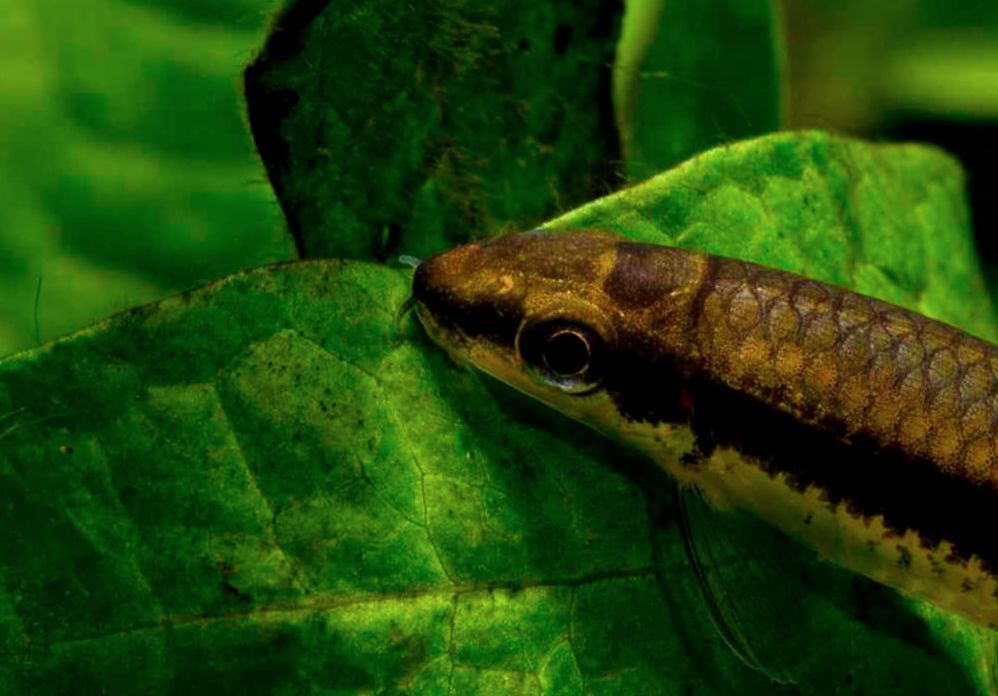
Difficulties in keeping
The Siamese algae eater is a peaceful and active fish that is not particularly demanding, making it a great addition to various aquariums. One of its standout features is its ability to combat black beard algae (BBA), a type of algae that many other fish species will not touch. This makes the SAE one of the few effective biological solutions for managing this persistent algae problem in tanks.
However, there is a caveat: for the Siamese algae eater to consume black beard algae effectively, it may need to be slightly underfed. This means that aquarists might need to slightly overfeed other food types to encourage the fish to target BBA. Juvenile SAE fish tend to eat black beard algae more eagerly compared to their adult counterparts, who generally prefer a diet consisting of live or artificial food. As such, understanding the dietary habits of these fish is crucial for maximizing their algae-eating potential.
Maintaining a balanced approach to feeding can help ensure that the Siamese algae eater remains effective in managing algae while also thriving in your aquarium environment.
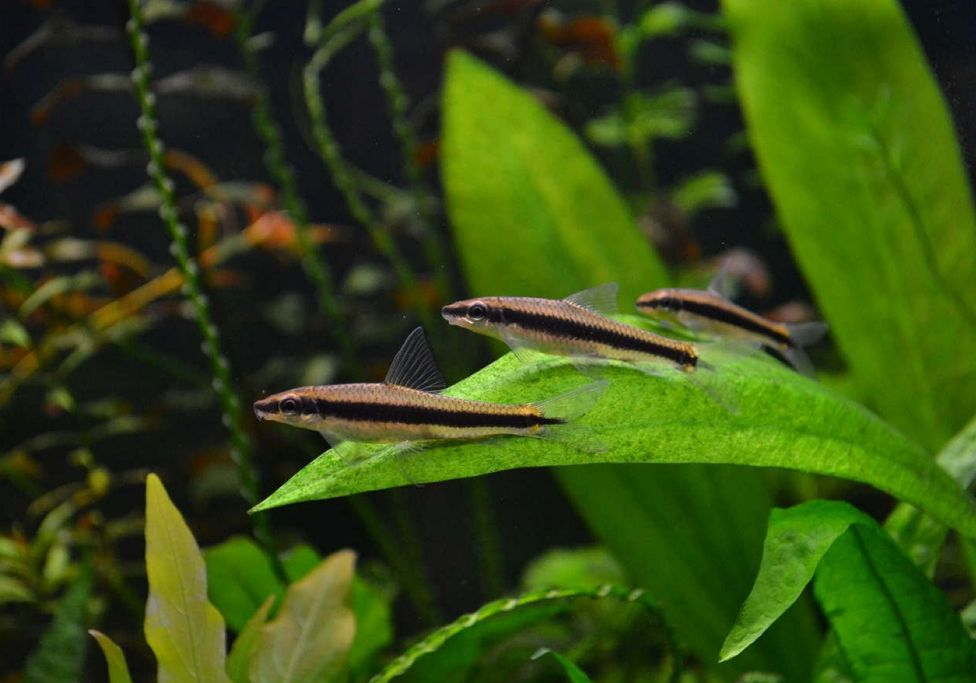
Keeping in a tank
Tank size
The Siamese algae eater is a relatively undemanding fish when it comes to tank conditions. Due to its size, it is recommended to keep a pair of adult Siamese algae eaters in a tank with a minimum capacity of 40 gallons (approximately 150 liters). Their lively nature adds energy and movement to the aquarium, enhancing the overall scenery.
Having a larger tank offers several advantages. It provides ample swimming space for these active fish, allowing them to exhibit their natural behaviors comfortably. A spacious environment also encourages the creation of a diverse and stimulating habitat, which can include elements such as rocks, driftwood, and live plants. These features not only contribute to the aesthetic appeal of the aquarium but also serve as hiding spots and resting areas for the fish.
Furthermore, a larger tank helps maintain stable water parameters, which is crucial for the health of all tank inhabitants. Stable conditions reduce stress and aggression among tankmates, promoting a harmonious community. The increased water volume also aids in diluting waste products, contributing to a healthier and more stable aquarium ecosystem.
Water parameters
Here are the recommended water parameters for maintaining the health and well-being of Siamese algae eaters:
- Water Temperature: Maintain a temperature range of 74°F to 79°F (23°C to 26°C). Siamese algae eaters thrive in tropical conditions, and keeping the water within this range helps ensure their comfort and activity levels.
- pH Level: Aim for a pH level between 6.5 and 7.5. While Siamese algae eaters can adapt to a wide range of water parameters, they prefer neutral to slightly acidic water for optimal health.
- Water Hardness: These fish do well in moderately soft to moderately hard water. Target a general hardness (GH) level between 5 to 12 dGH and a carbonate hardness (KH) level between 4 to 8 dKH to create a suitable environment.
- Ammonia, Nitrite, and Nitrate Levels: It is critical to keep ammonia and nitrite levels at 0 ppm, as these substances are toxic to fish. Nitrate levels should be kept below 20 ppm to prevent stress and health issues. Regular water changes and effective filtration are key practices for maintaining low nitrate levels.
- Filtration and Oxygenation: Siamese algae eaters prefer well-oxygenated water with moderate water flow. Adequate filtration is essential to remove waste and maintain high water quality, which is vital for the overall health of the fish.
Regularly testing the water parameters using reliable test kits is crucial for monitoring the aquarium’s conditions. Performing frequent water changes of around 20% to 25% of the total water volume every 1-2 weeks helps maintain stable water conditions and promotes the overall health of the fish.
Tank setup: decorations and plants
For Siamese algae eaters, it is ideal to have a long, thickly-planted tank with a moderate water flow. Their natural habitat consists of well-lit, fast-flowing streams and rivers, so replicating these conditions in the aquarium is essential. The water should be crystal clear and rich in oxygen; areas with stagnant water and low oxygen levels will likely make the Siamese algae eaters uncomfortable.
While they are active fish, the construction of their air bladder means they cannot stay submerged all the time. It is common to see them resting on the substrate or large leaves of aquatic plants. Therefore, organizing the tank with clusters of live plants and providing ample swimming space is recommended. This setup not only supports their natural behavior but also offers hiding spots and resting areas.
Since Siamese algae eaters can easily jump out of the tank, it is essential to cover the aquarium with a glass lid or some floating plants to prevent escapes.
Using small-sized gravel as a substrate is suitable for the tank’s bottom, and incorporating driftwood or rocks can enhance the habitat’s complexity. Lighting is flexible; both bright and scattered light conditions are beneficial for these fish. When choosing lighting fixtures for the tank, it’s important to consider the needs of any live plants you may include, ensuring that they receive adequate light for growth.
By creating an environment that mimics their natural habitat, you will help your Siamese algae eaters thrive and display their natural behaviors, contributing to a vibrant and balanced aquarium ecosystem.
Filtration
Siamese algae eaters are naturally found in ponds and streams with circulating water, making them well-suited to environments with clean, oxygen-rich water. To thrive in an aquarium setting, these fish prefer a gentle water flow that mimics their natural habitat. A consistent flow helps keep them active and comfortable, as it allows them to engage in their instinctual behaviors.
If your tank lacks sufficient water movement, you can easily create flow by using a powerful canister filter. This type of filtration system not only provides excellent water circulation but also effectively removes waste and maintains water quality.
In addition to proper water flow, regular maintenance is crucial for the health of your Siamese algae eaters. Aim to perform daily water changes of approximately 30% of the tank’s total capacity. Frequent water renewals help keep the water clean and well-oxygenated, promoting a healthier environment for your fish.
Diet
Siamese algae eaters are primarily herbivorous fish that thrive on a diet rich in various types of algae and plant matter in their natural habitat. In an aquarium setting, their diet should consist of a combination of algae-based foods along with supplementary plant-based and protein-rich options. These fish are adept at scraping algae from tank plants, decorations, and equipment, which helps keep the aquarium clean. Providing a well-balanced diet is essential to meet their nutritional needs and promote good health and vibrant coloration.
In the aquarium, Siamese algae eaters consume a variety of live, frozen, and dry specialized foods. A diversified diet rich in plant material is crucial; if the plant component is lacking, they may start nibbling on tank plants, particularly moss varieties. Juvenile Siamese algae eaters tend to consume algae more eagerly, while adult fish often prefer protein-rich foods.
Here are some suitable food options for Siamese algae eaters:
- Algae Wafers/Pellets: High-quality algae wafers or pellets specifically designed for herbivorous fish are widely available. These sinking foods contain essential nutrients and serve as the primary source of sustenance for Siamese algae eaters.
- Natural Algae: Allowing some algae to grow naturally in the aquarium provides a fresh source for grazing. You can also attach algae-covered rocks or decorations to create additional grazing spots for your fish.
- Blanched Vegetables: Offer blanched vegetables such as zucchini, cucumber, spinach, or lettuce. These should be softened by briefly boiling or steaming before feeding to make them easier for the fish to consume.
- Frozen or Live Foods: As part of a balanced diet, Siamese algae eaters can enjoy occasional treats of frozen or live foods, such as daphnia, brine shrimp, and bloodworms.
To ensure they receive a balanced diet, offer a variety of foods in small portions a couple of times a day. Be cautious of overfeeding, as this can lead to water quality issues and obesity in the fish. If there are other fish in the aquarium, monitor feeding to ensure that the Siamese algae eaters get their share, as they can be outcompeted by more aggressive tankmates.
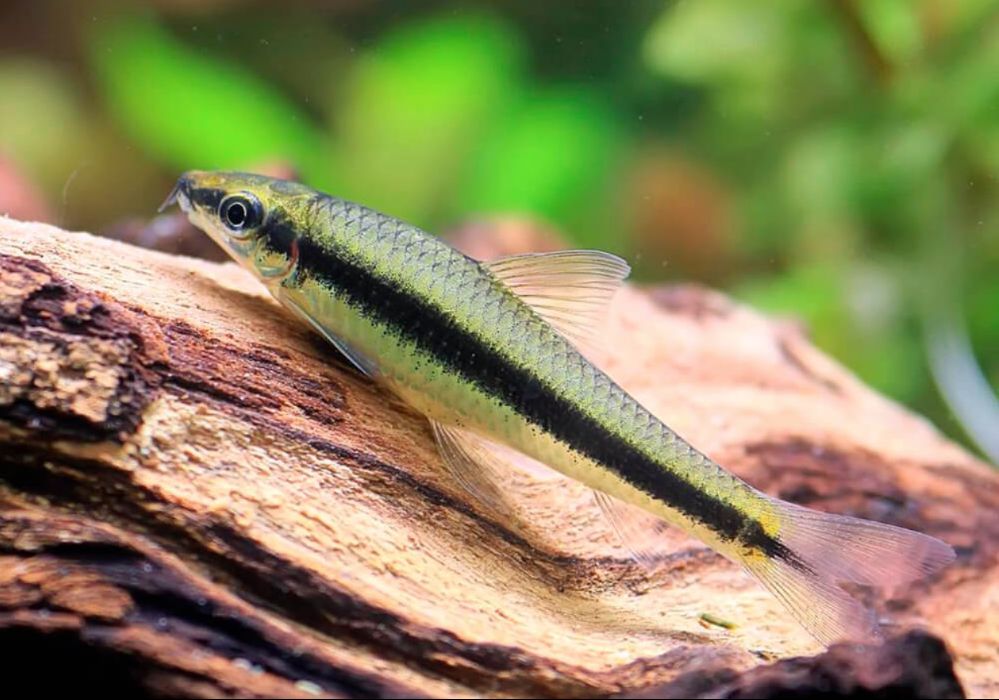
Tank mates
The Siamese algae eater is generally a good-tempered fish, making it a suitable tank mate for most unaggressive species. However, it’s best to avoid keeping them with long-finned fish, as Siamese algae eaters may nip at their fins.
One unwelcome tank mate for the Siamese algae eater is the rainbow shark. Both species are closely related and territorial, which often leads to aggressive confrontations. These fights can result in serious injury or even the death of one of the fish. Males, in particular, tend to be very territorial towards each other, so it is advisable to limit the number of male Siamese algae eaters in a small tank.
Due to their high activity levels, Siamese algae eaters can also be troublesome companions for cichlids, especially during the spawning period when cichlids are protective of their territory. The constant swimming of the Siamese algae eaters may disturb the cichlids, leading to stress and potential aggression.
In the wild, Siamese algae eaters often practice free floating and can become quite timid and hesitant when kept alone or in small groups. To promote natural behavior and social interaction, it is optimal to keep them in groups of 5-6 individuals or more, depending on the tank capacity. This larger group size not only enhances their confidence but also allows you to observe fascinating interactions and behaviors among them, creating a more dynamic and engaging aquarium environment.
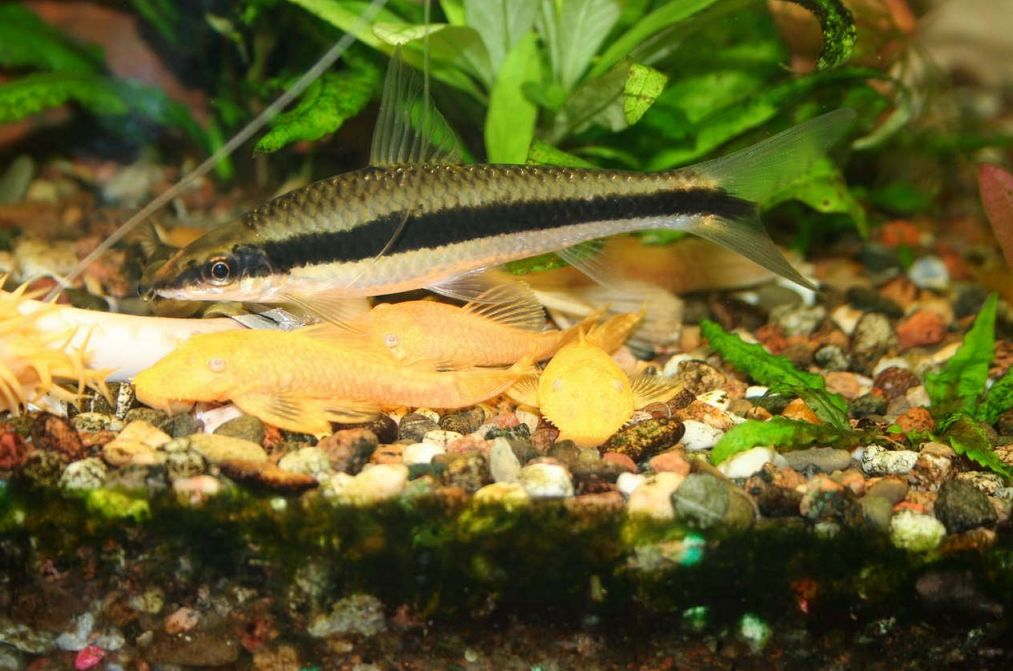
Gender differences: male vs female
Determining the sex of Siamese algae eaters can be quite challenging, especially when they are young or not in breeding condition. These fish do not exhibit significant external sexual dimorphism, meaning there are no obvious physical differences between males and females.
In some cases, mature female Siamese algae eaters may appear slightly larger and rounder when carrying eggs, but this distinction might not be readily apparent unless you are experienced or observe them closely during breeding behavior. Generally, the size difference is subtle and may not be noticeable in everyday observation.
Due to the difficulty in visually identifying their sex, most Siamese algae eaters are sold as unsexed individuals in the aquarium trade. If you are interested in breeding, it is advisable to acquire a group of these fish and allow them to pair naturally if they decide to do so. This approach increases your chances of finding a male-female pair.
It’s important to note that Siamese algae eaters are primarily kept for their exceptional algae-eating capabilities rather than for breeding. When maintained in groups, they can display fascinating schooling behaviors, which add dynamism to the aquarium. Furthermore, they contribute to maintaining a clean environment by grazing on algae and detritus, making them a valuable addition to any freshwater tank.
Breeding
There is currently no reliable information about Siamese algae eaters successfully breeding in a home aquarium without the use of hormonal agents. Most of the Siamese algae eaters available in the aquarium trade are either bred in fish farms or captured from the wild.
The lack of successful breeding in captivity makes it difficult for aquarists to establish breeding pairs at home. As a result, those interested in breeding Siamese algae eaters may need to consider purchasing young fish from reputable sources to ensure they are healthy and well cared for.